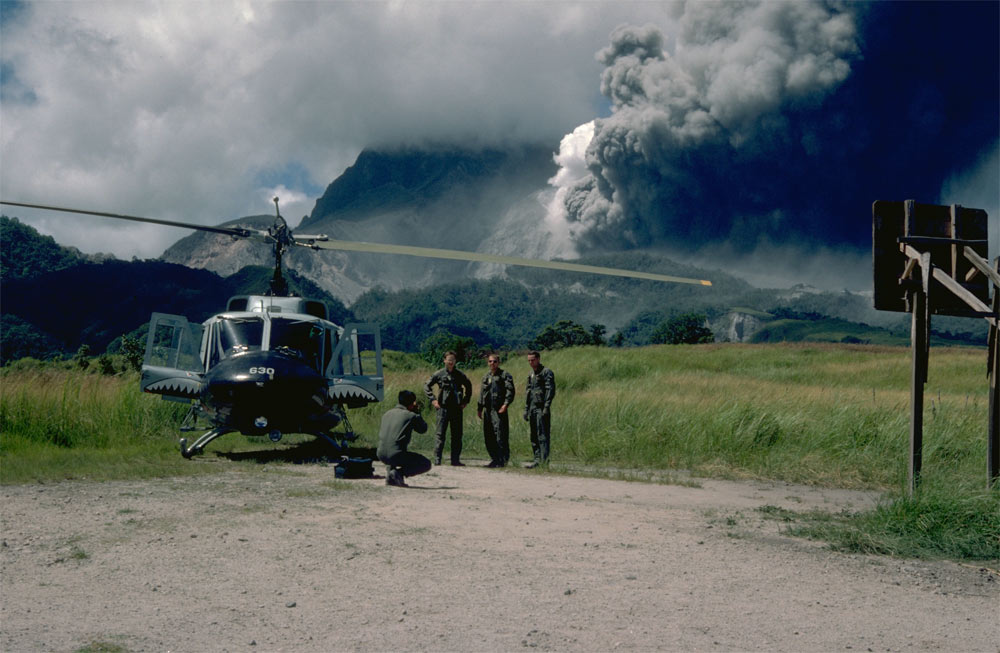Pinatubo Flashback, June 10, 1991: Hasty Evacuation

On June 15, 1991, the largest land volcano eruption in living history shook the Philippine island of Luzon as Mount Pinatubo, a formerly unassuming lump of jungle-covered slopes, blew its top. Ash fell as far away as Singapore, and in the year to follow, volcanic particles in the atmosphere would lower global temperatures by an average of 0.9 degrees Fahrenheit (0.5 degrees Celsius). Twenty years after Pinatubo, LiveScience is reliving the largest eruption in the modern era based on what we know now. Join us each day through June 15 for a blow-by-blow account of what happened. [Read all installments: June 7, June 8, June 9, June 10, June 11, June 12, June 13, June 14]
June 10, 1991 - It's a day of movement at Clark Airbase. The base's commander, Major General William Studer, has ordered an evacuation for 14,500 U.S. personnel and their dependents as Mount Pinatubo shows signs of an impending blowout.
The decision to evacuate is a potentially costly one, especially if the volcanoes rumblings drag on. The American and Philippine governments are in negotiations about extending the lease to the base, which is up in September. The threat of the volcano has thrown those negotiations into uncertainty.
Meanwhile, the American and Filipino volcano monitoring team are packing up, too. But they're not going far — just to the other side of the airbase. Clark has reliable power, water and communications, so the team needs to stay here to monitor the volcano's every grumble.
Twenty years on, the geologists realize that this move wouldn't have saved their lives, had Pinatubo's upcoming eruption been at full strength.
"If the eruption had been bigger than it was, it still wouldn't have been far enough, based on what we learned subsequently," John Ewert, the scientist-in-charge at the USGS Cascades Volcano Observatory, told LiveScience. "It turned out that what happened in 1991 was on the small side [for Pinatubo]."
As the base empties out, the monitoring team is left behind with only a skeleton crew of military personnel guarding expensive equipment. The team is subsisting on MREs (ready-to-eat meals used by the military) and whatever is left in the base's commissary. And though they're only a handful of kilometers from an angry volcano, they're almost hoping for an impressive eruption.
Sign up for the Live Science daily newsletter now
Get the world’s most fascinating discoveries delivered straight to your inbox.
"We've inconvenienced a lot of people and we've cost a lot of money evacuating people," Ewert said. His colleague, USGS volcanologist Richard Hoblitt, now also at Cascades Volcano Observatory, remembers that pressure wryly.
"If the volcano had not performed, it wouldn't have been very good for our careers, let's put it that way," Hoblitt told LiveScience.
Tomorrow: Waiting for Pinatubo to blow.
You can follow LiveScience senior writer Stephanie Pappas on Twitter @sipappas. Follow LiveScience for the latest in science news and discoveries on Twitter @livescience and on Facebook.

Stephanie Pappas is a contributing writer for Live Science, covering topics ranging from geoscience to archaeology to the human brain and behavior. She was previously a senior writer for Live Science but is now a freelancer based in Denver, Colorado, and regularly contributes to Scientific American and The Monitor, the monthly magazine of the American Psychological Association. Stephanie received a bachelor's degree in psychology from the University of South Carolina and a graduate certificate in science communication from the University of California, Santa Cruz.









